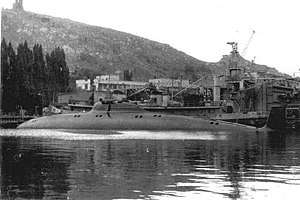Beluga-class submarine
Project 1710 Макрель (NATO reporting name "Beluga") was a Russian SSA diesel-electric submarine. It was an experimental vessel used for testing propulsion systems, hull forms, and boundary-layer control techniques.
 | |
| History | |
|---|---|
| Builder: | United Admiralty Shipyard 196 |
| Launched: | 1986 |
| Commissioned: | 1988 |
| Out of service: | 1998 |
| Stricken: | 2007 |
| Fate: | Stricken |
| General characteristics | |
| Type: | Submarine |
| Displacement: |
|
| Length: | 62.0–65.5 m (203 ft 5 in–214 ft 11 in) |
| Beam: | 6.3–8.7 m (20 ft 8 in–28 ft 7 in) |
| Draught: | 5.6–6.0 m (18 ft 4 in–19 ft 8 in) |
| Propulsion: | Diesel-electric |
| Speed: |
|
Development was undertaken by the Malakhit Design Bureau with construction at the Admiralty shipyard in St. Petersburg. [1]
The lone Beluga-class submarine in operation was S-553 Forel. Launched in 1986 and moth-balled around 1998, the last operation of the vessel is thought to have taken place in 1997. As of the mid-2000s, the entire project is believed to have been discontinued.
References
- Beluga Class Submarine Archived September 27, 2007, at the Wayback Machine
External links
This article is issued from Wikipedia. The text is licensed under Creative Commons - Attribution - Sharealike. Additional terms may apply for the media files.